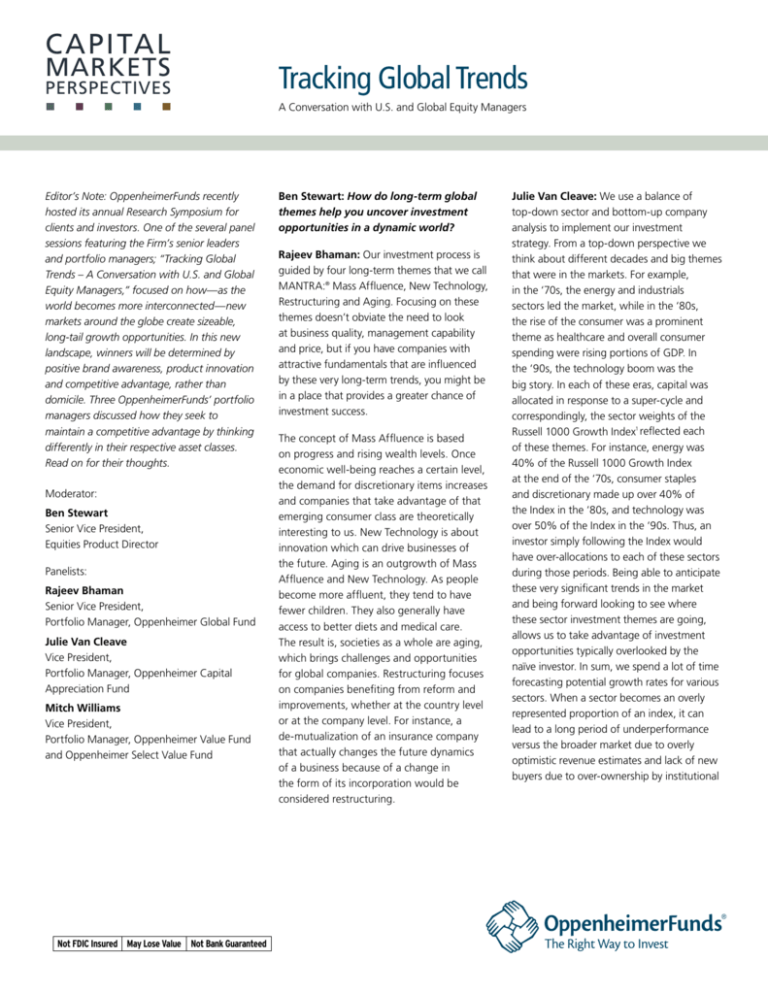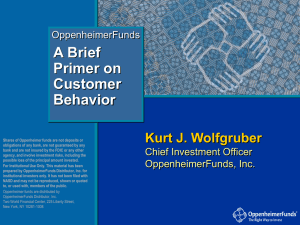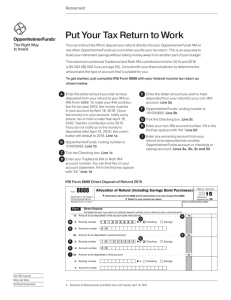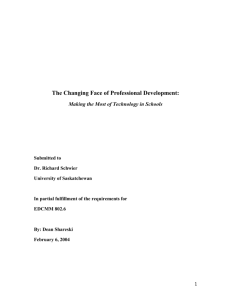
Capital
Markets
Perspectives
Tracking Global Trends
A Conversation with U.S. and Global Equity Managers
Editor’s Note: OppenheimerFunds recently
hosted its annual Research Symposium for
clients and investors. One of the several panel
sessions featuring the Firm’s senior leaders
and portfolio managers; “Tracking Global
Trends – A Conversation with U.S. and Global
Equity Managers,” focused on how—as the
world becomes more interconnected—new
markets around the globe create sizeable,
long-tail growth opportunities. In this new
landscape, winners will be determined by
positive brand awareness, product innovation
and competitive advantage, rather than
domicile. Three OppenheimerFunds’ portfolio
managers discussed how they seek to
maintain a competitive advantage by thinking
differently in their respective asset classes.
Read on for their thoughts.
Moderator:
Ben Stewart
Senior Vice President,
Equities Product Director
Panelists:
Rajeev Bhaman
Senior Vice President,
Portfolio Manager, Oppenheimer Global Fund
Julie Van Cleave
Vice President,
Portfolio Manager, Oppenheimer Capital
Appreciation Fund
Mitch Williams
Vice President,
Portfolio Manager, Oppenheimer Value Fund
and Oppenheimer Select Value Fund
Not FDIC Insured May Lose Value Not Bank Guaranteed
Ben Stewart: How do long-term global
themes help you uncover investment
opportunities in a dynamic world?
Rajeev Bhaman: Our investment process is
guided by four long-term themes that we call
MANTRA:® Mass Affluence, New Technology,
Restructuring and Aging. Focusing on these
themes doesn’t obviate the need to look
at business quality, management capability
and price, but if you have companies with
attractive fundamentals that are influenced
by these very long-term trends, you might be
in a place that provides a greater chance of
investment success.
The concept of Mass Affluence is based
on progress and rising wealth levels. Once
economic well-being reaches a certain level,
the demand for discretionary items increases
and companies that take advantage of that
emerging consumer class are theoretically
interesting to us. New Technology is about
innovation which can drive businesses of
the future. Aging is an outgrowth of Mass
Affluence and New Technology. As people
become more affluent, they tend to have
fewer children. They also generally have
access to better diets and medical care.
The result is, societies as a whole are aging,
which brings challenges and opportunities
for global companies. Restructuring focuses
on companies benefiting from reform and
improvements, whether at the country level
or at the company level. For instance, a
de-mutualization of an insurance company
that actually changes the future dynamics
of a business because of a change in
the form of its incorporation would be
considered restructuring.
Julie Van Cleave: We use a balance of
top-down sector and bottom-up company
analysis to implement our investment
strategy. From a top-down perspective we
think about different decades and big themes
that were in the markets. For example,
in the ‘70s, the energy and industrials
sectors led the market, while in the ‘80s,
the rise of the consumer was a prominent
theme as healthcare and overall consumer
spending were rising portions of GDP. In
the ‘90s, the technology boom was the
big story. In each of these eras, capital was
allocated in response to a super-cycle and
correspondingly, the sector weights of the
Russell 1000 Growth Index1 reflected each
of these themes. For instance, energy was
40% of the Russell 1000 Growth Index
at the end of the ‘70s, consumer staples
and discretionary made up over 40% of
the Index in the ‘80s, and technology was
over 50% of the Index in the ‘90s. Thus, an
investor simply following the Index would
have over-allocations to each of these sectors
during those periods. Being able to anticipate
these very significant trends in the market
and being forward looking to see where
these sector investment themes are going,
allows us to take advantage of investment
opportunities typically overlooked by the
naïve investor. In sum, we spend a lot of time
forecasting potential growth rates for various
sectors. When a sector becomes an overly
represented proportion of an index, it can
lead to a long period of underperformance
versus the broader market due to overly
optimistic revenue estimates and lack of new
buyers due to over-ownership by institutional
1234
tracking global trends
investors. The converse is true as well. When
a sector is an underrepresented proportion
of an index, it can lead to a prolonged period
of outperformance as the sector comes back
into favor and attracts new investors. We use
this top-down sector approach in conjunction
with our bottom-up stock selection, because
in terms of growth investing, it is all about
getting the big picture right.
Mitch Williams: As a value investor, we
focus on long-term earnings power and
drivers of change. The stocks we buy typically
look cheap when we’re buying them because
bad things have been happening to the
companies. In buying these stocks, we look
for drivers of change which can transform
the stock over time into a company that
looks healthier and has a richer valuation.
We categorize change as secular, cyclical and
turnarounds. Secular change means more
permanent alteration such as technology,
demographics or regulation. Cyclical
change is somewhat temporary, such as
the economic cycle moving up or down.
Turnarounds involve significant change of
the structure and organization of a company
that can unlock shareholder value.
2
Ben Stewart: How does your global
perspective influence your investment
process?
Mitch Williams: One of the important
things about identifying stocks that fall
into our categories of change is having a
global perspective. Our investment team is
organized according to six global value chains
and our analysts do a lot of travel outside the
U.S. This is unusual for a domestically focused
equity team but we think it is important
to visit these countries and companies to
experience and understand first-hand what’s
going on in the value chain. For example,
through our international travel we were able
to identify and better understand a German
chemicals company with strong technology
(thus falling into our secular change category)
that is listed in the U.S., but is well-positioned
to benefit from growth in China.
Rajeev Bhaman: On the global equity team,
our natural inclination if we come across a
U.S. company that produces a product or
service is to immediately investigate if there
is a German or Japanese company that
does it better. Although we look for global
growth themes, our focus is on companies,
not countries. Using our Mass Affluence
theme as an example, the broadening out of
purchasing power across the world is creating
meaningful opportunities for companies
related to consumption. In particular, we have
been quite interested in the idea of luxury
as something that will be advantaged as the
emerging market consumer gets wealthier.
Many luxury goods companies are European
and are generating an increasing portion
of their sales in emerging markets such as
China. The people in the developing world
are particularly keen to distinguish themselves
from their fellow man and owning luxury
goods is one way to do so.
Julie Van Cleave: We look at all corners of
the market for the best growth possible. In
the large-cap universe there are many U.S.
stocks that generate a significant portion
of their revenues overseas and we think it
is important to have a global perspective to
identify these opportunities. For example,
in the emerging markets, one in 10 mobile
phones sold last year was a smartphone,
while in North America one in three sold
was a smartphone. So, we are seeing this as
a strong trend globally, with more room to
grow and the demand for mobile data on
the rise. We think it is important to recognize
this theme and have identified U.S. large-cap
growth companies that we believe
are well-positioned to capitalize on this
growing demand.
Ben Stewart: Throughout history,
technological innovation has been
responsible for wide-scale wealth
creation. What opportunities are you
seeing in the technology space?
Julie Van Cleave: The biggest absolute
sector weight in Oppenheimer Capital
Appreciation Fund is technology and one
theme we are focusing on within the sector
is the infrastructure around consumer
mobility, smartphones and the portability
of data. Just as cell phones have been
replacing the need for landline phones, we
are seeing smartphones replacing the need
for computer-based Internet access. We are
witnessing a surge in data creation as well
as growing demand for the portability of
data. We believe there are several companies
that can benefit from this theme, including
semiconductor companies, mobile phone
makers and network providers.
Rajeev Bhaman: Our New Technology
theme is about innovation. Innovation
drives value creation and businesses of the
future. Opportunities cannot be created
without innovation. Related to the data and
mobility theme Julie mentioned, we are
seeing a proliferation of devices that use
semiconductors. However, manufacturing
semiconductors is becoming more
expensive. One way to solve this problem
is through programmable logic devices,
which are generic semiconductor chips
that can be customized with software.
This enables companies to “mass
customize” semiconductor chips in a costeffective manner. The industry also has
good competitive dynamics with two
leading companies.
Mitch Williams: Technology falls into our
secular change category. One theme we are
researching is the impact of vehicle emissions
regulations around the world. There are
over 22 secular emissions changes currently
in the legislative process aimed at vehicle
emissions. These aren’t subjects in the press,
because they’re not particularly interesting
to read about from a news perspective.
However, from an investment viewpoint,
there is opportunity for companies that have
intellectual property and new technologies
that can help countries adopt these new
vehicle emissions regulations. As a result
of our research, we have also uncovered
companies that may change the production
process of ethanol. Most people think of
ethanol as originating from sugarcane or
corn, which stresses food stocks. However,
there are companies that have technologies
to develop industrial and fuel ethanol from
coal, which could be a real game changer.
Ben Stewart: Given the boom we’ve
seen in commodity prices, what are your
thoughts on the sector?
Rajeev Bhaman: I don’t think this boom
will last. Everyone is focused on this idea
that China is going to consume more
commodities and prices will go up forever.
However, price does matter for consumption.
In the U.S. when gas goes to four dollars a
gallon, people drive less. The same is true
everywhere in the world. However, in China
you have a governmental sector that’s not
economically driven. We have not seen
consumption contract in the face of rising
energy prices because so far the Chinese
government has kept these higher prices
from being passed on to consumers. This can
go on as long as the government budget can
fund it but it is not a permanent solution. At
some point Chinese consumption of energy
will likely slow. We believe the changes will
come in terms of factories becoming more
energy efficient, by adjusting to variable
speed motors from fixed speed motors or
replacing incandescent bulbs with light
emitting diodes, for example.
Julie Van Cleave: There is incrementally
larger demand for more commodities;
however, commodity price spikes happen
for a variety of different reasons including
weather, accidents or geopolitical unrest in
oil-producing nations. We prefer to focus
on the long term and look through these
short-term spikes which are likely fueled
by speculative investors. Over the long
term we think it will be challenging and
incrementally more expensive to find more
commodity resources, which will likely
move prices up. New supply will increasingly
depend upon new technologies, such as
U.S. shale liquids or complex drilling in ultradeep water. The industry is likely to face
increased environmental protection costs
due to regulatory repercussions of last year’s
Gulf of Mexico oil spill. We are interested
in companies that are good at integrating
commodity costs into their cost of
production, through increasing efficiencies
and hedging, as well as companies that
provide goods and services that will help
energy producers comply with potential
new regulations. n
Mitch Williams: We focus on bottom-up
stock selection, thus when it comes to
whether commodities boom or bust, my
preference is to try to neutralize that scenario
in a portfolio. I don’t want an inherent
commodity price to be driving performance
one way or the other. We do fundamental
analysis and when we have an opinion on
where oil prices may be headed we may
adjust our positioning on the margin. If you
looked at our portfolio overall, right now,
we’re positioned to potentially benefit from
a falling oil price, but it is not a significant
bet in our fund.
3
tracking global trends
Get
Started
Visit oppenheimerfunds.com
Call your financial advisor
Call us, 1.800.CALL OPP (225.5677)
1.The Russell 1000 Growth Index is a widely used measure of large-cap growth stock performance. The index is unmanaged and cannot be purchased
directly by investors. Index performance is shown for illustrative purposes only and does not predict or depict the performance of any Oppenheimer fund.
Shares of Oppenheimer funds are not deposits or obligations of any bank, are not guaranteed by any bank, are not insured by the FDIC or any other agency,
and involve investment risks, including the possible loss of the principal amount invested.
Investing in foreign securities entails special risks (such as currency fluctuations and political factors), and may have higher expenses and volatility. Value
investing involves the risk that undervalued securities may not appreciate as anticipated. Investments in securities of technology companies may be
volatile. Commodity-linked investments are considered speculative and have substantial risks, including the risk of loss of a significant portion of their
principal value. Diversification does not guarantee profit or protect against loss.
Before investing in any of the Oppenheimer funds, investors should carefully consider a fund’s investment objectives, risks, charges and expenses. Fund
prospectuses and, if available, summary prospectuses contain this and other information about the funds, and may be obtained by asking your financial
advisor, visiting our website at oppenheimerfunds.com or calling us at 1.800.CALL OPP (225.5677). Read prospectuses and, if available, summary
prospectuses carefully before investing.
Oppenheimer funds are distributed by OppenheimerFunds Distributor, Inc.
Two World Financial Center, 225 Liberty Street, New York, NY 10281-1008
© 2011 OppenheimerFunds Distributor, Inc. All rights reserved.
DS0000.108.0511 May 31, 2011
qwer












